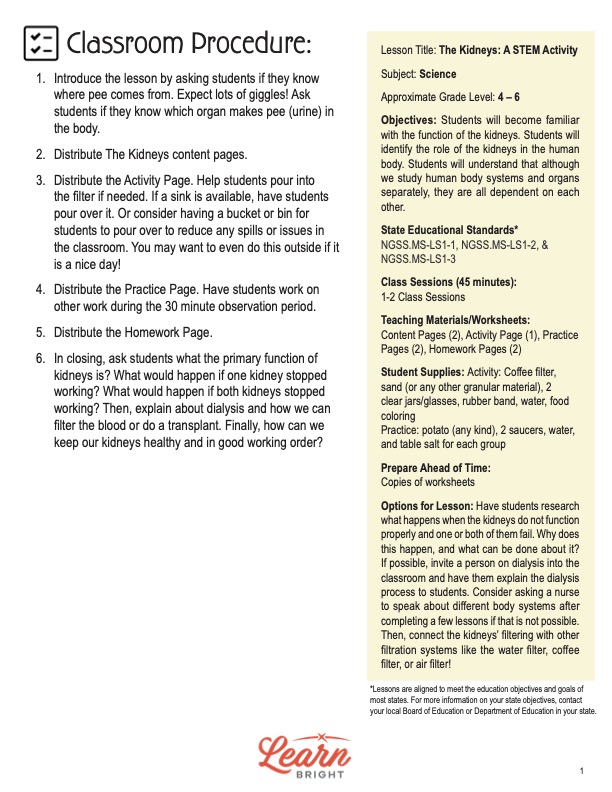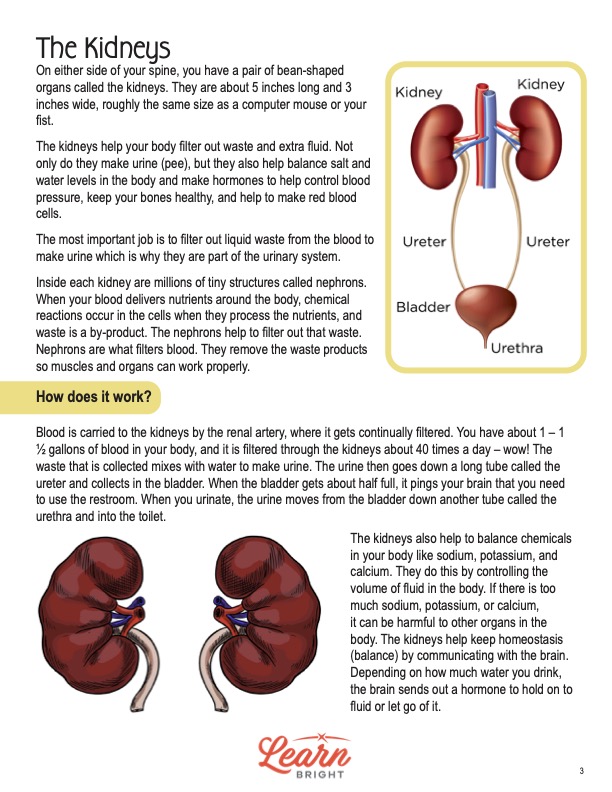Description
What our Human Kidneys STEM lesson plan includes
Lesson Objectives and Overview: Human Kidneys STEM explores the role and functions of the kidney. Students will discover why kidneys are so important to the body. They will learn that these organs are responsible for removing waste and regulating the body’s sodium-water balance. This lesson is for students in 4th grade, 5th grade, and 6th grade.
Classroom Procedure
Every lesson plan provides you with a classroom procedure page that outlines a step-by-step guide to follow. You do not have to follow the guide exactly. The guide helps you organize the lesson and details when to hand out worksheets. It also lists information in the yellow box that you might find useful. You will find the lesson objectives, state standards, and number of class sessions the lesson should take to complete in this area. In addition, it describes the supplies you will need as well as what and how you need to prepare beforehand. Both the activity and practice worksheets require some materials. For the activity, you need coffee filters, sand or similar granular material, glass jars or glasses, rubber bands, water, food coloring. The practice requires potatoes, saucers, water, and table salt.
Options for Lesson
The “Options for Lesson” section of the classroom procedure page lists a number of suggestions for ideas and activities you could incorporate into the lesson. One idea is to have students research what happens when one or both kidneys fail, why this happens, and what can be done about it. If possible, you could also invite a person on dialysis to come to the class and explain the dialysis process to students. Another option is to consider asking a nurse to speak about different body systems after completing a few lessons about other parts of the body. One more idea is to compare how kidneys filter substances with other filtration systems like the water filter, coffee filter, or air filter.
Teacher Notes
The paragraph on this page gives you a little more information on the lesson overall and describes what you may want to focus your teaching on. It mentions that this lesson will likely be light-hearted given the subject matter. The blank lines are available for you to write out any thoughts or ideas you have as you prepare.
HUMAN KIDNEYS STEM LESSON PLAN CONTENT PAGES
Introduction to Kidneys
The Human Kidneys STEM lesson plan contains two content pages. Our kidneys, a pair of organs with a bean-like shape, rest on either side of the spine. They are about five inches long and three inches wide, roughly the same size as a computer mouse or average fish. These important organs help the body filter out waste and extra fluid.
Kidneys are also responsible for producing urine, and they help balance the salt and water levels in the body. But they have even more responsibilities. They secrete hormones that help control blood pressure, keep bones healthy, and help make red blood cells. Their most important job, however, is to filter out liquid waste from the blood to make urine, which is why they are part of the urinary system.
Inside each kidney are millions of tiny structures—nephrons. When our blood delivers nutrients around the body, chemical reactions occur within the cells when they process the nutrients. Waste becomes a by-product of these reactions. Nephrons help filter out that waste and are thus the structures that filter our blood. They remove waste products so that muscles and organs can work properly.
How They Work
Students will then learn how exactly their kidneys accomplish all these tasks. Blood flows to the kidneys by the renal artery, where the nephrons continually filter it. The body has about one to one and a half gallons of blood in the body. And the kidneys filter that blood about 40 times a day! The waste the kidneys collect mixes with water to make urine.
The urine then travels down a long tube—the ureter—and collects in the bladder. Once the bladder is about half-way full, it sends a message to the brain saying that it’s time to release that urine. When a person urinates, the urine moves from the bladder and down another tube called the urethra and exits the body.
Kidneys help balance various chemicals in the body, like sodium, potassium, and calcium. They do this by controlling the volume of fluid within the body. Too much salt or other chemicals can harm the other organs, so kidneys help maintain homeostasis by communicating with the brain. Depending on how much water we drink, the brain sends out a hormone to hold on to or let go of the fluid.
As mentioned before, kidneys also produce hormones that help regulate blood pressure to ensure the heart beats normally. The hormone increases the production of red blood cells as well. This is important because red blood cells deliver oxygen to the cells and take away the waste.
If our kidneys stop working, there are several things that could have caused the problem. Health issues like diabetes, cancer, high blood pressure, and autoimmune diseases can cause problems for the kidneys. In addition, so can various injuries and using illegal drugs. The kidneys are essential organs that help keep the body functioning at its best.
HUMAN KIDNEYS STEM LESSON PLAN WORKSHEETS
The Human Kidneys STEM lesson plan includes three worksheets: an activity worksheet, a practice worksheet, and a homework assignment. These worksheets will help students demonstrate what they learned throughout the lesson and reinforce the lesson concepts. The guide on the classroom procedure page outlines when to hand out each worksheet to your students.
JAR FILTER ACTIVITY WORKSHEET
Students will use various materials to create a filtering system that represents how kidneys filter out waste. If you want, you can pair students up for this task. First, students will fill one jar with water and add two to three drops of red food coloring followed by two spoonfuls of sand. On the worksheet, they will fill in the blanks on the two prompts about what these materials represent.
Next, they will place a coffee filter over the top of the second glass and secure it with a rubber band. They will again respond to prompts about what the jar and coffee filter represent. Then they will carefully pour the contents of blood and waste through the filter and into the empty glass. The worksheet lists four questions for students to answer after they complete the experiment.
SALTY POTATOES PRACTICE WORKSHEET
The practice worksheet provides students the opportunity to consider the effects of salt on the body. They will first fill two dishes with water. They will mix one teaspoon of salt into one dish and label the dish salt. Next, they will place a potato half into each dish—cut-side down—and wait for 30 minutes.
Once the half hour is up, students will observe their potatoes and then respond to the prompts on the worksheet. They will read a short statement about how salty food and drinks can affect the salt-water balance in the body. Finally, they will respond to the final two prompts.
HUMAN KIDNEYS STEM HOMEWORK ASSIGNMENT
For the homework assignment, students will track the water they drink over the course of three days. The worksheet provides a table of 18 water drops, six in each column for each day. Students will color in a drop for every cup of water they drink that day.
Worksheet Answer Keys
The lesson plan document provides answer keys for the three worksheets. Answers will vary on some of the questions because of the nature of those prompts. The correct answers are in red to make it easy for you to compare them to students’ work. If you choose to administer the lesson pages to your students via PDF, you will need to save a new file that omits these pages. Otherwise, you can simply print out the applicable pages and keep these as reference for yourself when grading assignments.









